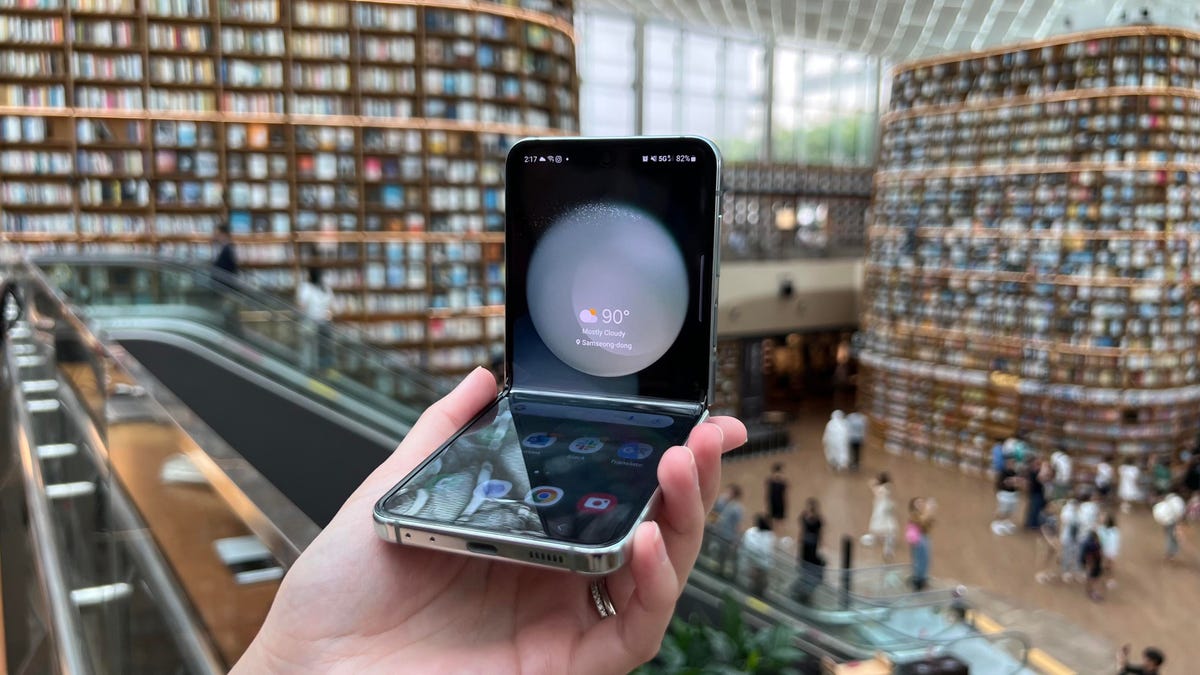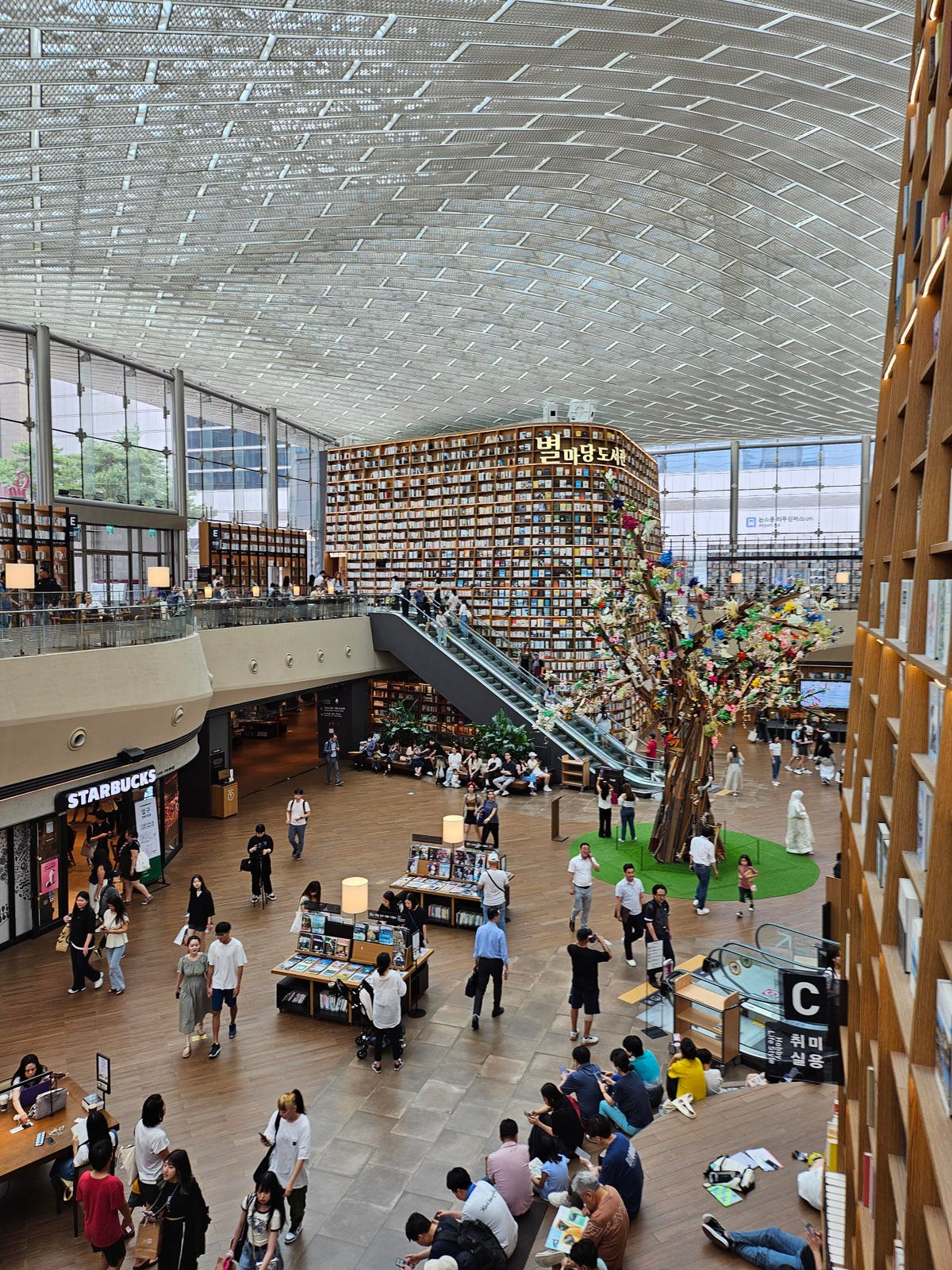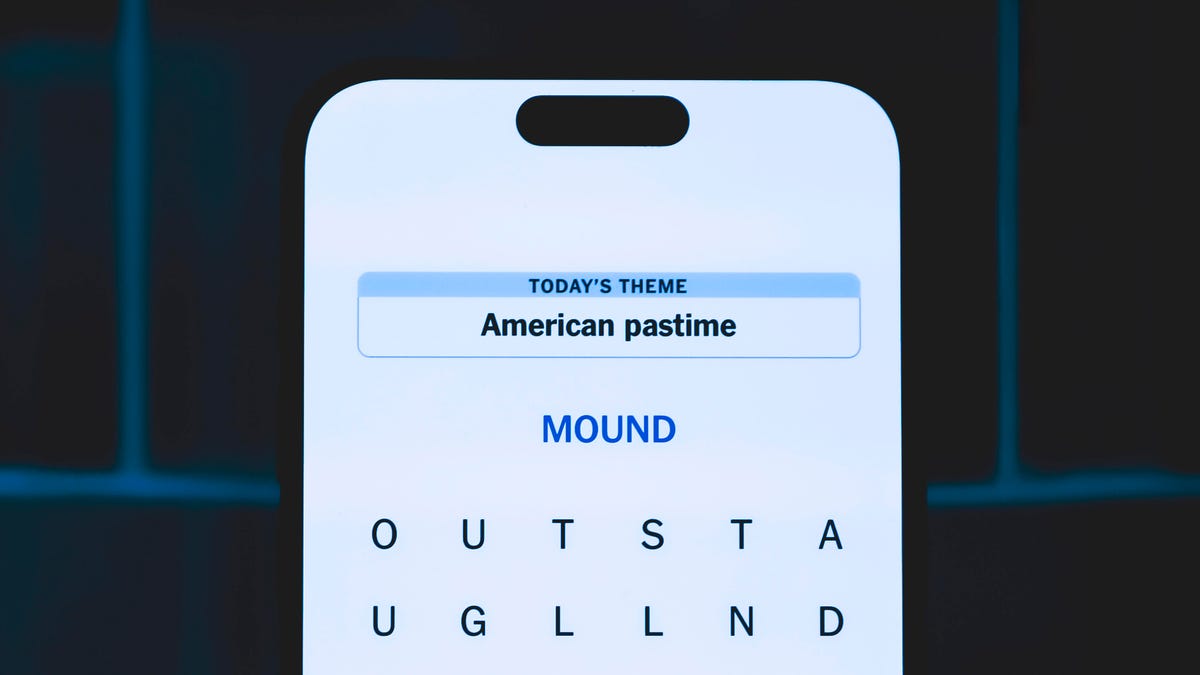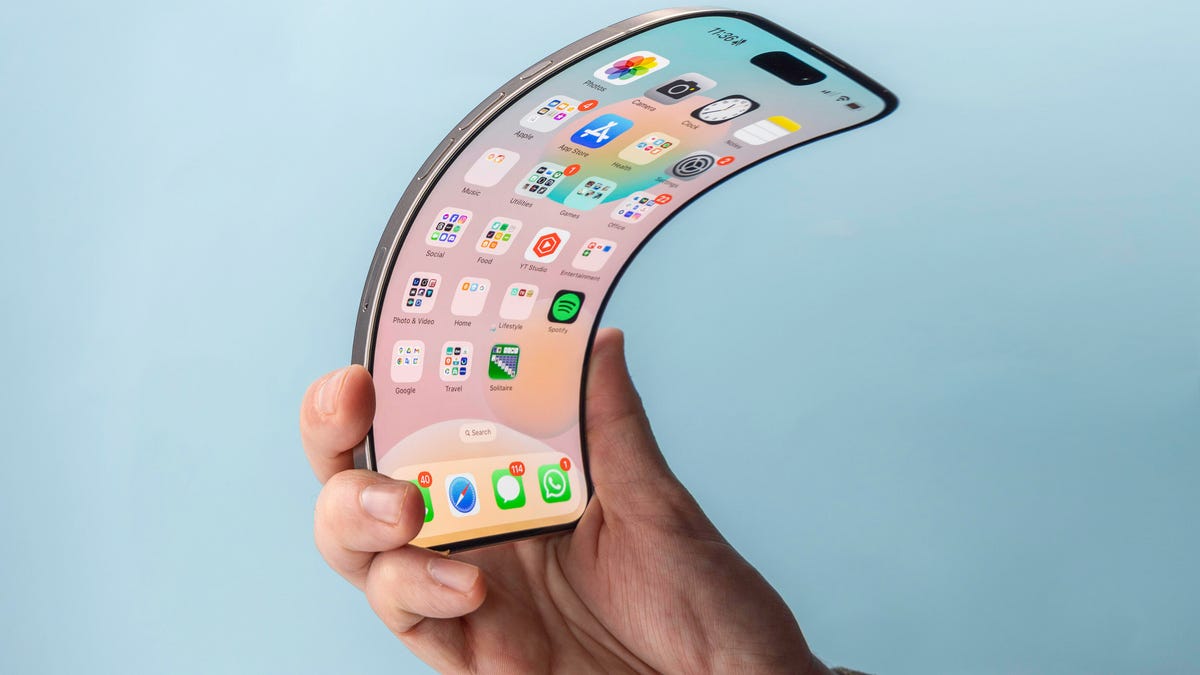Technologies
My Galaxy Z Flip 5 Impressions After Using It for a Day
The Samsung Galaxy Z Flip 5’s new cover screen makes a big difference even after just a day with the new phone.

The new Galaxy Z Flip 5 feels like the biggest upgrade to Samsung’s flip phone in years. And it’s all because of the clamshell phone’s giant new cover screen.
It’s only my first day using the Galaxy Z Flip 5, but it already feels like a major departure from the Galaxy Z Flip 4. The Z Flip 5’s spacious cover screen makes the foldable more purposeful when it’s closed. The external screen is no longer just for quick checks of your calendar or the weather; you can actually interact with apps and reply to messages from it.
The Galaxy Z Flip 5 is a step forward for the Z Flip line, though Samsung isn’t the first to explore new uses for the cover screen. Motorola did the same with its new Razr Plus, which just launched in June. It’s difficult to tell which flip phone is better after such a limited amount of time with the Z Flip 5. But right off the bat, I can see how Samsung’s and Motorola’s approaches differ.
Here’s a closer look at my first impressions of the Galaxy Z Flip 5.

The new cover screen has a lot of potential
The larger cover screen, which Samsung calls the Flex Window, feels intuitive and useful so far. It’s primarily designed for showing widgets, but you can also access a select number of apps. This felt limiting at first, considering you can run just about any app on the Razr Plus’ external display.
But after a little time with the Z Flip 5, I’m starting to see why this makes sense. Samsung is going for a curated experience that relies more heavily on widgets and notifications rather than full apps.
While I enjoy having the option to open any app on the Razr Plus’ front screen, apps can look squished on a display that small. This applies to the Z Flip as well, which is likely why Samsung limits which apps are supported. However, Samsung says you’ll be able to use Samsung’s Good Lock launcher to run additional apps on the Z Flip 5’s cover screen.
Even though the cover screen doesn’t support every app, you can still reply to notifications from unsupported apps. For example, tapping a notification for a direct message I received on Instagram gave me the option to type a response.
So far, I’ve been using the cover screen for basic tasks like scrolling through notifications, setting alarms and reading WhatsApp messages. As was the case with the Razr Plus, I had to go into the settings menu to grant apps access to the cover screen.
At the time of writing, I didn’t see Spotify listed as an option for the external display, which is a shame since I loved propping up the Razr Plus with its front screen facing outward to quickly cycle between tracks. Since I’m traveling in South Korea right now, I’d also appreciate the option to access Google Translate on the external display.
I’m interested to see what Samsung does with the new Flex Window cover screen. Right now both Samsung and Motorola provide a straightforward experience that involves cycling through a carousel of widgets, checking notifications and launching apps. But both cover screens feel like a halfway point between a smartwatch and a phone. They’re glanceable and compact like a watch, but also large enough for tapping, swiping and typing comfortably. That makes me think there are probably new ways to optimize software, apps and even accessories for this front display in ways we haven’t seen yet, whether that comes from Samsung or a competitor like Motorola.

Samsung closes the gap
The other major aesthetic change to the Galaxy Z Flip 5 is its new hinge. When shut, both the Galaxy Z Flip 5 and Galaxy Z Fold 5 close completely, with no gap near the hinge. But according to Samsung, this is more than just a cosmetic upgrade; it should also improve durability since there are fewer moving parts. Of course, we won’t know how true that is until people get their hands on the Galaxy Z Flip 5 for an extended period of time.
So far, I really enjoy the Galaxy Z Flip 5’s more compact look. By comparison, the Razr Plus feels thinner and lighter and it also has a gapless hinge, so Samsung isn’t first in this regard. But there’s something about Samsung’s phone that feels a bit sturdier. Sometimes I have to give the top half of the Razr Plus a little extra push when opening it to get it to unfold completely. The Galaxy Z Flip 5 opens up straight without any extra effort. But it’s also important to keep in mind that I’ve had the new Z Flip for only a day. I used the Razr Plus over a couple of weeks, so there’s more wear and tear on it.
The Galaxy Z Flip 5’s main screen still has a crease, and it’s just as noticeable as the one on the Galaxy Z Flip 4. During my time in Seoul, I’ve been observing which phones are popular. And I see people using many more Z Flips compared with back home in New York. One way I’m able to tell whether a passerby is using a Galaxy Z Flip — even from a distance — is to see if the screen has a crease. It’s clearly a difficult challenge for any company making a phone with a folding screen, but I hope Samsung solves it in the near future.
The Galaxy Z Flip 5 gets the same chip as the Galaxy S23
Both the Z Flip 5 and Z Fold 5 both run on the same Qualcomm Snapdragon 8 Gen 2 for Galaxy processor as the Galaxy S23 series. I look forward to seeing how this impacts battery life and camera performance, since I noticed the Galaxy S23 series improve in both those areas.
My full review will have more tests and comparisons against the Galaxy Z Flip 4 to see how much of a difference the new chip makes. But so far, my battery has dipped from full down to 80% after roughly five and a half hours of use, which seems promising considering I had the adaptive brightness and high refresh rate settings turned on.
The Galaxy Z Flip 5 has 12-megapixel wide and ultrawide cameras like the Z Flip 4, but Samsung added a new coating to help reduce lens flare. I haven’t had time to compare the Z Flip 5 against other phones, but here are some of my favorite photos taken in Seoul so far.




The Galaxy Z Flip 5 feels like a step in the right direction for Samsung’s flip phone. I’m not sure if gives people who aren’t already interested in flip phones a reason to buy one, but it’s on the right track.
Samsung Galaxy Z Flip 5 specs vs. Motorola Razr Plus, Samsung Galaxy Z Flip 4, Motorola Razr 2023
| Samsung Galaxy Z Flip 5 | Motorola Razr Plus | Samsung Galaxy Z Flip 4 5G | Motorola Razr 2023 | |
| Display size, tech, resolution, refresh rate, brightness | Cover: 3.4-inch AMOLED (728 x 720 pixels); internal: 6.7-inch AMOLED (2,640 x 1,080 pixels), 1-120Hz | Cover: 3.6-inch OLED (1,066 x 1,056 pixels); internal: 6.9-inch (2,640 pixels x 1,080) | Cover: 1.9-inch AMOLED (512 x 260 pixels); internal: 6.7-inch (2,640 x 1,080 pixels) | Cover: 1.5-inch, OLED (194 x 368 pixels); internal: 6.9-inch (2,640 pixels x 1,080) |
| Pixel density | Cover: 306 ppi, Internal: 425 ppi | Cover: 413 ppi, internal: 413ppi | Cover: 302 ppi, internal: 425 ppi | Cover: 282 ppi, internal: 413 ppi |
| Dimensions (inches) | Open: 6.5 x 2.83 x 0.27 in; closed: 3.35 x 2.83 x 0.59 in | Open: 2.91 x 6.73 x 0.28 in; closed: 2.91 x 3.48 x 0.59 in | Open: 2.83 x 3.3 x 0.67 in; closed: 2.83 x 6.5 x 0.27 in; hinge: 0.59 in (sagging) | Open: 2.91 x 6.73 x 0.29 in; closed: 2.91 x 3.47 x 0.62 in |
| Dimensions (millimeters) | Open: 71.88 x 165.1 x 6.89 mm; closed: 71.88 x 85.09 x 14.99 mm | Open: 73.95 x 170.83 x 6.99 mm; closed: 73.95 x 88.42 x 15.1 mm | Open: 71.9 x 165.2 x 6.9 mm; closed: 71.9 x 84.9 x 17.1 mm; hinge: 15.9 mm (sagging); | Open: 73.95 x 170.82 x 7.35 mm; closed: 73.95 x 88.24 x 15.8 mm |
| Weight (grams, ounces) | 187 g (6.6 oz) | 189 g (6.64 oz) | 187 g (6.59 oz) | 189 g (6.65 oz) |
| Mobile software | Android 13 | Android 13 | Android 12/13 | Android 13 |
| Camera | 12-megapixel (main), 12-megapixel (ultrawide) | 12-megapixel (main), 13-megapixel (ultrawide) | 12-megapixel (main), 12-megapixel (ultrawide) | 64-megapixel (main), 13-megapixel (ultrawide) |
| Front-facing camera | 10-megapixel | 32-megapixel | 10-megapixel | 32-megapixel |
| Video capture | TBD | 4K | 4K | 4K |
| Processor | Snapdragon 8 Gen 2 | Snapdragon 8 Gen 1 | Snapdragon 8 Plus Gen 1 | Snapdragon 7 Gen 1 |
| RAM/storage | 8GB + 256GB/512GB | 8GB + 256GB | 8GB+ 128GB/256GB/512GB | 8GB + 128GB |
| Expandable storage | None | None | None | None |
| Battery | 3,700 mAh (dual-battery) | 3,800 mAh | 3,700 mAh | 4,200 mAh |
| Fingerprint sensor | Side | Side | Side | Side |
| Connector | USB-C | USB-C | USB-C | USB-C |
| Headphone jack | None | None | None | None |
| Special features | 5G-enabled, IPX8 water resistance, 25W wired charging, wireless charging, wireless power share, dual SIM | IP52, 5G-enabled, foldable display, 30W wired charging, wireless charging | IPX8, 5G enabled, foldable display, wireless charging, 25W fast charging | IP52, 5G-enabled, foldable display, 30W wired charging, 5W wireless charging |
| US price off-contract | $1,000 | $1,000 | $999 | TBA |
| UK price | £1,049 | Converts to £780 | £999 | TBA |
| Australia price | AU$1,649 | Converts to AU$1,475 | AU$1,499 | TBA |
Technologies
Today’s NYT Strands Hints, Answers and Help for Nov. 27 #634
Here are hints and answers for the NYT Strands puzzle for Nov. 27, No. 634.

Looking for the most recent Strands answer? Click here for our daily Strands hints, as well as our daily answers and hints for The New York Times Mini Crossword, Wordle, Connections and Connections: Sports Edition puzzles.
Today’s NYT Strands puzzle has a holiday theme. Some of the answers are difficult to unscramble, so if you need hints and answers, read on.
I go into depth about the rules for Strands in this story.
If you’re looking for today’s Wordle, Connections and Mini Crossword answers, you can visit CNET’s NYT puzzle hints page.
Read more: NYT Connections Turns 1: These Are the 5 Toughest Puzzles So Far
Hint for today’s Strands puzzle
Today’s Strands theme is: With gratitude.
If that doesn’t help you, here’s a clue: Today’s the day.
Clue words to unlock in-game hints
Your goal is to find hidden words that fit the puzzle’s theme. If you’re stuck, find any words you can. Every time you find three words of four letters or more, Strands will reveal one of the theme words. These are the words I used to get those hints but any words of four or more letters that you find will work:
- MALE, MALES, DIAL, THEY, HONK, WRIT, ENDS, HEAL
Answers for today’s Strands puzzle
These are the answers that tie into the theme. The goal of the puzzle is to find them all, including the spangram, a theme word that reaches from one side of the puzzle to the other. When you have all of them (I originally thought there were always eight but learned that the number can vary), every letter on the board will be used. Here are the nonspangram answers:
- FOOD, LIFE, FAMILY, FRIENDS, HEALTH, WORK, COMMUNITY
Today’s Strands spangram
Today’s Strands spangram is THANKFUL. To find it, start with the T that’s five letters down on the far-left row, and wind up and across.
Toughest Strands puzzles
Here are some of the Strands topics I’ve found to be the toughest in recent weeks.
#1: Dated slang, Jan. 21. Maybe you didn’t even use this lingo when it was cool. Toughest word: PHAT.
#2: Thar she blows! Jan.15. I guess marine biologists might ace this one. Toughest word: BALEEN or RIGHT.
#3: Off the hook, Jan. 9. Similar to the Jan. 15 puzzle in that it helps to know a lot about sea creatures. Sorry, Charlie. Toughest word: BIGEYE or SKIPJACK.
Technologies
Google’s Pixel Buds Pro 2 Just Hit a New Low of $134 in Amazon’s Black Friday Sale
We’ve never seen these earbuds fall this low, but we don’t expect this deal to last for long.
If you’re in the market for a new pair of earbuds this Black Friday, now’s your chance to get them. We’ve found a great discount on the Google Pixel Buds Pro 2 thanks to the Cyber Week festivities. They’re among the best wireless earbuds as our top pick for Android users and, at just $134, they’re a bargain to boot.
That’s a new low for these earbuds, but do be aware that it only applies to the moonstone color currently. That could change at any moment, though, so make sure to check the price of the other colors if moonstone isn’t your thing. Either way, we don’t expect this price to last for long, so order sooner rather than later.
The earbuds provide noticeably improved sound quality and noise cancellation compared to their predecessor. They’re built with Google’s powerful Tensor A1 chip and designed to offer rich, immersive sound. It’s the first time a Google Tensor chip has been featured in any earbuds and the result is robust active noise cancellation and advanced sound.
The Google Pixel Buds Pro 2 earbuds deliver deep bass with their built-in 11 mm drivers and a new high-frequency chamber for smoother treble. CNET’s audio expert David Carnoy noted that compared to the original Pixel Buds Pro, «there’s more depth and richness to the sound with better overall definition and extension.» Read his full review of the Pixel Buds Pro 2 to get the full lowdown.
These buds also got a design upgrade, with Google making them 27% smaller and 24% lighter to securely fit even more ear types. If you want to wear them during workouts, there’s a twist-to-adjust stabilizer to help lock your earbuds in place while you’re moving around and sweating.
There’s also a conversation detection feature that pauses your music and switches your earbuds to the transparency mode if you start talking. And with an impressive 30-hour battery life, you can listen to all your favorite songs, audiobooks and podcasts for hours on end without having to recharge.
HEADPHONE DEALS OF THE WEEK
-
$248 (save $152)
-
$170 (save $181)
-
$298 (save $131)
-
$199 (save $150)
Why this deal matters
At $134, these earbuds are a great buy thanks to advanced active noise cancellation, impressive sound quality and a lengthy battery life. The current deal makes the Pixel Buds Pro 2 earbuds cheaper than ever. But the deal won’t be around for long, so act fast if you want to take advantage of this awesome discount.
Join Our Daily Deals Text Group!
Get hand-picked deals from CNET shopping experts straight to your phone.
By signing up, you confirm you are 16+ and agree to receive recurring marketing messages at the phone number provided. Consent is not a condition of purchase. Reply STOP to unsubscribe. Msg & data rates may apply. View our Privacy Policy and Terms of Use.
Technologies
Apple Desperately Needs to Launch a Foldable iPhone Flip Next Year
Commentary: Apple is the only major phone company without a folding phone. That needs to change in 2026.

Apple’s iPhone 17 came and went and while we certainly love the iPhone 17 Pro and its vibrant cosmic orange color, I can’t help but be disappointed that the long-rumored foldable iPhone Flip wasn’t part of the company’s September launch event. Most Android phone-makers, including Samsung, Google, Motorola, OnePlus, Xiaomi and Honor are multiple generations into their own folding phone lineups, and it’s beginning to feel like Apple is late to the party. That might be a problem.
Apple dominates in the premium phone category, but foldables — which fit into the premium space in terms of price — are already nipping at its heels, with Motorola telling CNET that 20% of customers buying its Razr foldable jumped ship from Apple. Meanwhile, Samsung is in the seventh generation of its Flip and Fold series. As Lisa Eadicicco discovered during a visit to Seoul, «foldables are everywhere» in Samsung’s home country of South Korea.
With nearly every major Android phone-maker entering the foldable market, Apple risks losing potential customers. It also runs the risk of letting a rival like Samsung become the go-to name for foldables, which could make it harder for Apple to make an impact if it eventually launches its own device. Furthermore, early adopters drawn to foldable tech may be too entrenched in the Android ecosystem by the time Apple’s phone arrives to want to switch to iOS.
Apple is unlikely to be worried. It’s estimated that around 20 million foldables from all manufacturers were sold worldwide in 2023, while Apple reportedly sold 26.5 million iPhone 14 Pro Max handsets in the first half of that year alone. In 2024, foldable sales were flat — and 2025 isn’t fairing much better, according to analysts at CounterPoint Research, although Samsung did report record numbers of preorders for its latest foldable. Clearly, Apple feels it has yet to miss the boat.
Apple has always found success in biding its time, observing the industry and launching its own take on a product when it’s ready. Apple didn’t invent phones, tablets, smartwatches or computers, but it found ways to take existing products and make them more useful, more valuable in day-to-day life and — dare I say — more exciting. It’s why the iPhone, iPad, Apple Watch and Mac lines dominate the market today.
For me, I need to see Apple’s take on the foldable phone. I’ve written before about how disappointed I am in foldables. I’ve been a mobile reporter for over 14 years and phones have become increasingly dull as they’ve converged to become slight variations on the same rectangular slab.
Read more: Best Flip Phone for 2025
Foldables promised something new, something innovative, something that briefly sparked some excitement in me, but several years in, that excitement has dwindled to the point of being extinguished. They are fine products and while I like the novelty of a screen that bends, they’re not a revolution in how we interact with our phones. Not in the way that the arrival of the touchscreen was when we were still pushing buttons to type out texts.
I did hope that Google’s Pixel Fold would be the phone to catapult the foldable forward, and while the recent Pixel 10 Pro Fold — the second generation of Google’s foldable — does offer some great updates, it still doesn’t offer any kind of revolution. Instead, it feels more like a «me too» move from Google. Ditto for the OnePlus Open. So I’m left instead to look toward Apple, a company with a track record for product revolutions, to create a new take on the genre that genuinely drives forward how we use our phones.
That innovation won’t just come from the product design. Apple works closely with its third-party software developers, and it’s that input that would help a folding iPhone become genuinely useful. My biggest complaint around foldables right now is that while the hardware is decent, the devices are essentially just running standard versions of Android with a handful of UI tweaks thrown in. They’re regular phones that just happen to bend.
Few Android developers are embracing the folding format, and it’s not difficult to see why; the users aren’t there in sufficient numbers yet to justify the time and expense to adapt their software across a variety of screen sizes. The multiple folding formats already available mean Android foldables face the same fragmentation issue that has plagued the platform since the beginning. Android-based foldables are simply a more difficult platform for developers to build for than regular phones. Apple would be able to change that, as it proved with the iPhone and iPad.
Given Apple’s close relationships with top-tier developers — not to mention its own vast developer team — I expect an eventual Apple foldable to offer innovations that make it more than just an iPhone that folds in half.
And I truly hope it does. I want to look forward to tech launches again. I want to feel excited to get a new gadget in my hands and feel that «wow» moment as I do something transformative for the first time.
In short, I don’t want to be bored by technology anymore. Apple, it’s over to you.
-

 Technologies3 года ago
Technologies3 года agoTech Companies Need to Be Held Accountable for Security, Experts Say
-

 Technologies3 года ago
Technologies3 года agoBest Handheld Game Console in 2023
-

 Technologies3 года ago
Technologies3 года agoTighten Up Your VR Game With the Best Head Straps for Quest 2
-

 Technologies4 года ago
Technologies4 года agoBlack Friday 2021: The best deals on TVs, headphones, kitchenware, and more
-

 Technologies4 года ago
Technologies4 года agoVerum, Wickr and Threema: next generation secured messengers
-

 Technologies4 года ago
Technologies4 года agoGoogle to require vaccinations as Silicon Valley rethinks return-to-office policies
-

 Technologies4 года ago
Technologies4 года agoOlivia Harlan Dekker for Verum Messenger
-

 Technologies4 года ago
Technologies4 года agoiPhone 13 event: How to watch Apple’s big announcement tomorrow
